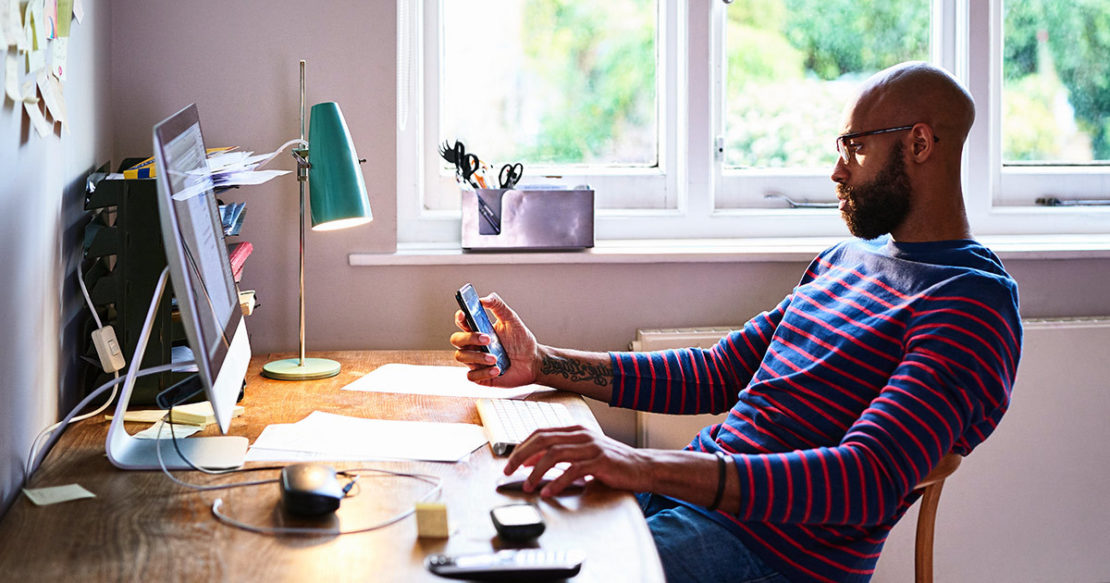The COVID-19 pandemic has fundamentally changed the way we work. While people are beginning to return to offices across the UK, many still remain working from home.
A study by Bupa found that since lockdown 11 million (1,2) people have suffered aches and pains due to working from home. Only a third have a dedicated workstation leaving many working from sofas, beds and even beanbags (3).
For many, one of the key things to be affected by a makeshift workstation is their posture – often leading to pain or discomfort. While working from home, people may find their setup doesn’t offer them the same level of support they have in the office. If sitting at their kitchen chair or on their sofa, employees may develop bad posture which may result in neck pain, shoulder tension and often recurring headaches.
To check your posture, ask someone to take a photo of you when you’re sitting at your desk with your normal working posture. Make sure it’s your typical posture and you’re not sat up tall – and take the photo of you from side on. You should be able to draw a line down from your chin to your sternum – or very close.
Adam outlines some common signs of bad posture while working from home and how to help fix it:
Slumped shoulders – rounded or slumped shoulders are one of the most common signs of bad posture. It’s often a result of sitting at a desk and leaning forward over a computer. While working from home this may have become worse, as you’re away from the usual office desk and chair which are designed to help stop you slumping over your computer. Excessive time spent like this can lead to a tightening of the muscles in the shoulders and weakening of the back muscles causing your shoulders to slump.
How to help it: try some different stretches. Stand with your hands by your sides, palms facing forwards, squeeze your shoulder blades together and slowly lift your arms until you feel a stretch in the muscles of the chest and shoulder. Repeat this 3-5 times. Another good remedy is shoulder lifts, where you slowly lift your shoulders towards your ears as you inhale, then roll them back down while you exhale.
Exercise can also help improve slumped shoulders by strengthening your back, core and shoulder muscles. Side planks are a good exercise which engage all of these muscles.
Neck pain – this often stems from a forward head carriage, which is also referred to as ‘text neck’ as it’s associated with excessive use of a mobile phone or tablet. Hunching over a laptop while working from a sofa can also be a cause. The forward slant of the neck places more stress on the cervical spine, creating a muscle imbalance as the neck finds it harder to hold the head in this position.
How to help it: chin tucks are a good way to strengthen the neck muscles. You can do these by sitting up tall in a chair, keeping your chin parallel to the floor. Gently move your head and chin backwards, without tilting your head. You should feel this stretch the back of your neck. Then push your head up away from your neck as if you were being pulled upwards, keeping your jaw relaxed and hold the position for three deep breathes
Recurring headaches – there are lots of possible reasons for headaches, but people are often surprised to hear that posture can be a cause. It’s particularly common in those with forward head carriage, as this puts extra stress on the neck and spine. Headaches are caused when the tension of holding our head in this position spreads to the back of the skull.
How to help it: if you’re suffering with recurring headaches, speak with a doctor in the first instance. If it’s confirmed that they’re linked to posture, a physio will be able to look at the strength and mobility in the neck. They will advise a strengthening and stretching programme to help relieve symptoms. You can also try massaging the back of the neck to relieve pressure.
Back pain – poor posture can lead to muscle imbalance which result in pain throughout the back. Depending on your posture, you may experience pain in different areas of your back. Many people find they suffer with pain in their lower back due to bad posture.
How to help it: sit up straight in a chair with your hands on your thighs and your shoulders down. Pull your shoulders back, squeeze the shoulder blades together and hold for five seconds. Repeat this three to four times daily to engage your back muscles and work on your posture. Regular exercise helps to strengthen and mobilise your back muscles and joints.
Tilted pelvis – sitting for a long period of time, in particular if you’re working from home, can cause tightness in your hips. This can result in your pelvis rotating forward and causing pain.
How to help it: working on strengthening your glutes can help with pelvic pain. Squats, lunges and planks are all good exercises to help with this, try to add them into your weekly workout regime. If you work at a desk, take regular breaks where you get up and move around and ensure you’re sitting with good posture.
- Research conducted among 2,003 UK adults by Opinium Research between 24-27 April 2020.
- Opinium estimates the UK adult population is 52,079,000. According to research undertaken by Opinium 34% of adults are currently working or home schooling from home (or 17,706,860 individuals). Of home workers 63% reported aches, pains or injury, equating to 11,155,322.
- 18% work from sofa or armchair, 12% work in bed, 5% work on a beanbag









